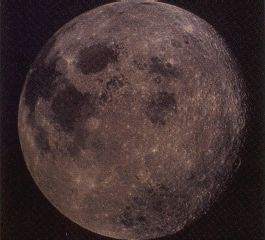
Moon

![]()
The Moon is Earth's single natural satellite. The first human footsteps on an alien world were made by American astronauts on the dusty surface of our airless, lifeless companion. In preparation for the human-crewed Apollo expeditions, NASA dispatched the automated Ranger Surveyor and Lunar Orbiter spacecraft to study the Moon between 1964 and 1968.
NASA's Apollo program left a large legacy of lunar materials and data. Six two-astronaut
crews landed on and explored the lunar surface between 1969 and 1972, carrying back a
collection of rocks and soil weighing a total of 382 kilograms (842 pounds) and consisting
of more than 2,000 separate samples.
From this material and other studies, scientists have constructed a history of the Moon
that includes its infancy. Rocks collected from the lunar highlands date to about 4.04.3
billion years old. The first few million years of the Moon's existence were so violent
that few traces of this period remain. As a molten outer layer gradually cooled and
solidified into different kinds of rock, the Moon was bombarded by huge asteroids and
smaller objects. Some of the asteroids were as large as Rhode Island or Delaware, and
their collisions with the Moon created basins hundreds of kilometers across.
This catastrophic bombardment tapered off approximately four billion years ago, leaving
the lunar highlands covered with huge, overlapping craters and a deep layer of shattered
and broken rock. Heat produced by the decay of radioactive elements began to melt the
interior of the Moon at depths of about 200 kilometers (125 miles) below the surface.
Then, for the next 700 million years -- from about 3.8 to 3.1 billion years ago -- lava
rose from inside the Moon. The lava gradually spread out over the surface, flooding the
large impact basins to form the dark areas that Galileo Galilei, an astronomer of the
Italian Renaissance, called maria, meaning seas.
As far as we can tell, there has been no significant volcanic activity on the Moon for
more than three billion years. Since then, the lunar surface has been altered only by
micrometeorites, by the atomic particles from the Sun and stars, by the rare impacts of
large meteorites and by spacecraft and astronauts. If our astronauts had landed on the
Moon a billion years ago, they would have seen a landscape very similar to the one today.
Thousands of years from now, the footsteps left by the Apollo crews will remain sharp and
clear.
The origin of the Moon is still a mystery. Four theories attempt an explanation: the Moon
formed near Earth as a separate body; it was torn from Earth; it formed somewhere else and
was captured by our planet's gravity, or it was the result of a collision between Earth
and an asteroid about the size of Mars. The last theory has some good support but is far
from certain.
From
'Information Summaries,' National Aeronautics and Space Administration, June 1991. PMS
010-A (JPL)
![]()